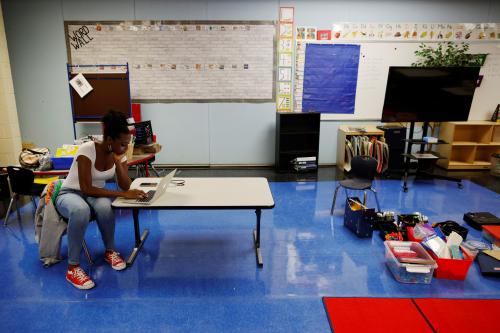Teacher compensation reform has reemerged as an urgent policy topic over the past month, with bills introduced in both chambers of Congress to incentivize states to pay teachers a $60,000 minimum annual salary. This is in addition to calls for action from nearly a dozen state governors to meaningfully increase teacher pay during recent state of the state addresses. Not since the wave of teacher strikes during the spring of 2018 has there been such widespread, focused attention on teacher pay.
Over the years, I have thought and written much about teacher compensation. They are underpaid in comparison to similarly educated professionals—by an estimated 24% in 2021 (adjusted for inflation)—and this will only grow without decisive action. I agree they should be paid more for the important work they do in the nation’s classrooms.
Yet, at the same time, I hesitate to endorse the push for a blanket minimum salary. Here, I offer my perspective on what our objectives with teacher compensation reform should be, downsides of the proposed salary minimum, and offer some critical elements of compensation reform that would provide more bang for the buck.
Defining success
Current calls for teacher compensation reform are motivated by concerns about teacher shortages, which have been nearing a crisis point during the pandemic. Further, supply lines through university-based training programs have been weakening for more than a decade; now down by more than a third since 2008. Areas of weakness include racially diverse college graduates. Salary minimum proposals appear primarily aimed at increasing earnings enough to shore up the teacher pipeline and motivate current teachers to stay in the classroom.
I argue, however, that simply attracting more people and reducing attrition is not enough. If we’re going to spend financial and political capital on teacher compensation reform, we must offer more than a one-size-fits-all solution to a complex problem.
We know teachers are important for many reasons, impacting student learning and many other related outcomes. Great teachers improve students’ lives not just while in their classrooms, but years and even more than a decade later. Yet, students have highly unequal access to great teachers, and this issue is wholly different from the availability of somebody to cover a classroom. Uneven access occurs both within and across schools, and it’s socioeconomically disadvantaged students who suffer.
Teacher compensation reform will be a success in my book when we can ensure consistent access to quality teaching for all students, not just slow the revolving door.
Skepticism for the $60,000 minimum salary
First, the problem isn’t just about money. Though teacher salaries are low (and more money always helps), salary’s importance in teacher attrition is quite small. To wit—recent analyses from two different states have shown those leaving public schools tend to take lower salaries than what they earned as teachers. Rather, teachers often identify working conditions, leadership, and culture as primary reasons for dissatisfaction and departure. Thus, efforts that pair teacher support with compensation reform are going to have a higher chance of success than salary increases alone.
Second, we don’t have a global shortage of teacher talent, but a local one. Teacher shortages follow predictable patterns of being most acute in high-need school settings (serving students from low-income backgrounds and located in rural or urban areas) and in specialized fields (mostly STEM subjects and special education). Shortages and underqualified teacher counts also tend to be higher in low-spending states. In other words, many schools have little difficulty finding the talent they need to serve their students well; thus, we need not overspend in places where staffing problems do not exist. Instead, conserve those resources to use where they’re really needed. A global minimum salary provides little reason to expect that any of these local issues would be adequately addressed.
Additionally, federal efforts to supplement teacher compensation are unprecedented in practice. As I’ve written previously, proposals to supplement salaries from the federal level will face some politically delicate hurdles, including that higher teacher pay will further pressure many already at-risk state pension systems and a policy that disproportionately rewards the lowest-paying states could become a flashpoint. Leveraging the tax code, as the Center for American Progress has previously recommended, through the expansion of targeted tax credits for teachers appears to me as the most politically viable federal strategy. However, it is not now under serious consideration from what I can see. For these reasons, I expect federal efforts to reform teacher pay will likely fizzle, though I hope state-led efforts can make a difference, and I encourage more focus there.
Compensation reforms that can achieve success
Here are four research-based recommendations to both pay teachers more and promote a robust supply of quality teachers to all students, regardless of the setting they find themselves in.
- Pay teachers more for teaching in high-need schools and subjects. Given the profile of hard-to-staff vacancies, the most obvious place to target funds for pay raises should be in these same school settings and subject specializations. Several prior studies have evaluated the efficacy of bonuses (or loan forgiveness) targeted to high-need areas and have found positive impacts on retention. This is where we need to be ambitious, though, as pay differentials need to be large to overcome teachers’ tendencies to otherwise flee high-need settings. Also, paying teachers in high-need settings more will disproportionately benefit and likely attract teachers of color, who tend to be clustered in such settings.
- Pay teachers more for high-quality teaching, especially when they take on extra responsibilities. With the objective to promote universal access to quality teaching, we should reward quality directly. Pay-for-performance programs were not popular among teachers during the early 2010s when many districts and states were experimenting with them; however, the evidence to date says these policies were largely successful when thoughtfully implemented for multiple years. Policies that prioritized quality encouraged strong teachers to stay in the classroom, and they helped identify weaker teachers for support. Contrary to popular belief, teacher turnover was often lower in settings with such policies. They may have even been critical in minimizing COVID-19 learning losses. Even more, some districts have experimented with putting high-quality teachers into special roles—including large bonuses in high-need schools, or as instructional coaches, or even just giving them larger class sizes. Paying quality teachers to take on these extra responsibilities can increase their pay, increase disadvantaged students’ access to quality teaching, and provide support to colleagues. Win – win – win.
- Pay all teachers at the master’s degree rate, without making them get one. Currently, most teachers feel compelled to pursue graduate education as the only viable avenue to increase their pay (typically amounting to about 10% of pay) beyond accumulating experience. Yet, these efforts are generally in vain from students’ perspectives, as studies show teachers’ educational attainment provides essentially no benefit for students. Graduate education is also a major driver of debt loads among teachers. Graduate studies will still be desirable for those who aspire to go into leadership roles, though far fewer teachers will find it necessary once the pay bump is automatic. This is a blanket salary increase I can get behind: we should save teachers’ time and money and simply pay all of them at the master’s degree rate.
- Do more to supplement the pay of preschool teachers, not just K-12 teachers. Preschool teachers are egregiously underpaid, given the value they add to students and their parents—a hard lesson emerging from the pandemic. Preschool teacher is one of the most common occupations among low-wage workers in the U.S. with an associate degree or higher. Plus, if there’s a clear policy window for federal lawmakers to support teacher salaries, it’s to support pre-kindergarten teachers’ salaries. Head Start programs are already supported through federal funds, and expanding the reach of these programs will benefit more students as they enter school and over the long run.
The current policy focus on teacher compensation presents a rare opportunity to do something big in education that—if done right—could meaningfully benefit both teachers and the students they serve. Let’s not squander this opportunity with a wet blanket.







Commentary
Ways to reform teacher compensation, beyond a $60,000 minimum salary
March 8, 2023